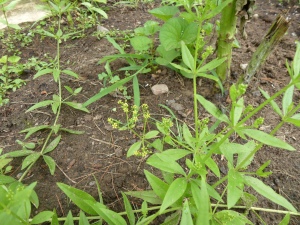The Madder plants that I have been growing for the past three years were all started from seed. The germination rate has been very good – I’d say over 75%, and the plants were fairly easy to transplant into the garden. Once established (second or third year) they started to spread nicely and this year some second-season plants have bloomed!
There is still some room in the Madder patch, so I’ve attempted 2 methods to establish some additional plants – cuttings rooted in pots of soil, and using wire staples to keep longer shoots on existing plants in place in the soil so they develop roots of their own, much like strawberry runners do.
The cuttings are a second attempt – first time I put some in a jar of water (with a small shoot of willow to encourage rooting) and all they did was rot. Most of the cuttings in pots rotted as well, but a couple did root and have now been planted out in the Madder patch.
I think it’s too soon to tell if the shoots held down in the soil with staples (made from lengths of hanger wire) are rooting themselves. They do look healthy, but they are still attached to the parent plants.
Madder appears to be a nice hardy plant in our 3a (Canadian climate) zone. It grows best in the same conditions that Lavender likes.
I’ve tried all the same methods to propagate Lavender, with no success – has anyone been able to propagate Lavender from cuttings? How did you get it to root?













